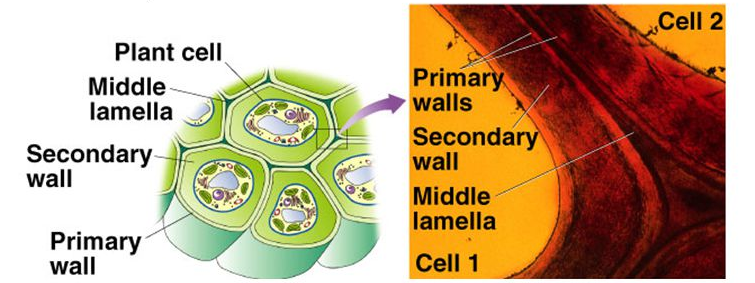The constituents of the plant cell walls vary depending on the stage of development and the type of tissue. In fact, when analyzing the structure-function relationship, one should always consider the plurality of plant cell types (ca 35 different types in plants, Cosgrove, 2005) with characteristic walls since their composition and macromolecular organization are adapted to a particular mechanical or physiological role. The multiplicity of cell wall types in the plant kingdom not only is due to the diversity of tissues types but also to the botanical origin. However, the fundamental macromolecular constitution of the cell walls relies on a common basis of polysaccharides, polyphenols and proteins, and it is the variability of the primary structure of these macromolecules, their relative proportion and their mutual arrangement that creates such a multiplicity.

Each region of the wall harbors a specific network of polymers adapted to its particular role in the plant tissue.
• Middle lamella – this is the outermost layer, constituting the glue that binds adjacent cells. It is composed primarily of pectic polysaccharides and lignin.
• Primary wall – this is the first wall deposited by cells before and during active growth. It is the outer wall and elongates and expands over the life of the plant cell. The primary wall of dicot cells is comprised of pectic polysaccharides (ca. 30%), cross-linking glycans (hemicellulose ; ca 25%), cellulose (15-30%) and protein (ca. 20%) Darvill et al, 1980. The actual content of the wall components varies with species and age. All plant cells have a middle lamella and primary wall.
• Secondary Wall – some cells deposit additional layers inside the primary wall. This occurs after growth stops, or when the cells begin to differentiate (specialize). The secondary wall is mainly for support and is comprised primarily of cellulose, hemicelluloses and lignin. Often distinct layers, S1, S2 and S3 can be distinguished – which differ in the orientation, or direction, of the cellulose microfibrils.
• Reaction wood layers – due to various stresses, plants, and specially trees, differentiate secondary walls with modified or additional layers such as the gelatinous layer (G-layer) of tension wood. [for a review see The biology of reaction wood, B. Gardiner et al. Eds, Springer, 2014]
In most models of plant cell wall, and in numerous reviews entitled “The plant cell wall …”, the presentation of the sole primary wall is often described as representative. Somerville, 2004Cafall, 2009Considering that the primary wall is only a few percent of the mature walls, this leads to a somewhat reductive and misleading view of the actual plant cell wall as a whole, given the importance of the lignocellulosic biomass. This situation arises from the biological importance of primary wall during the biosynthetic elaboration of a plant, as well as from the uncertain knowledge of the complex interconnections occurring between the polymers in the secondary wall due to the presence of lignin.
